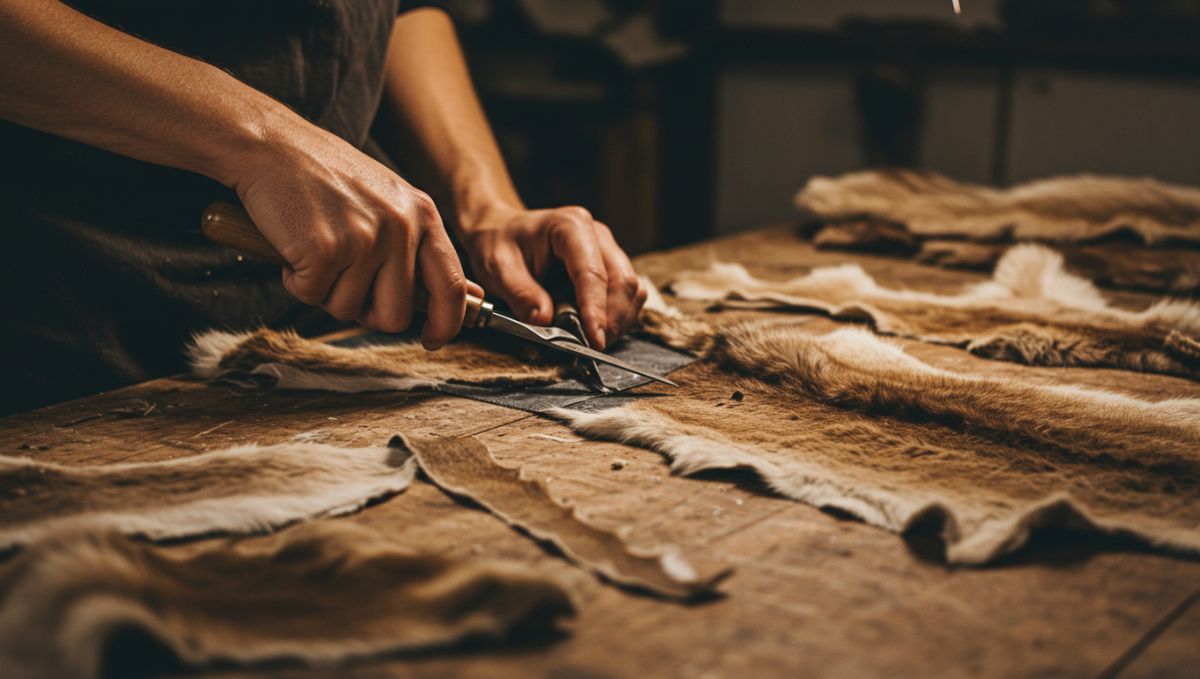The word Zuschneidfelle comes from German, translating to “cutting furs” or “fur cutting pieces.” It is a term commonly used in the context of leatherwork, fur tailoring, and textile crafts. Historically, Zuschneidfelle were materials prepared by furriers and tailors, often in small sections, to be cut and sewn into garments, accessories, or decorative items.
Today, the topic of Zuschneidfelle opens an interesting window into traditional craftsmanship, fashion history, and the ongoing debates about sustainability and ethics in the textile industry. In this article, we will explore the origins of Zuschneidfelle, their role in tailoring and fashion, the tools and techniques used in handling them, and the contemporary relevance of this once-niche craft material.
Historical Background of Zuschneidfelle
The use of animal hides and furs dates back thousands of years, long before modern fabrics existed. Early human societies depended on fur for warmth, durability, and survival in harsh climates. Over centuries, these practices evolved into sophisticated crafts.
In Europe, especially in Germany and neighboring regions, the furrier’s trade became a respected profession. Tailors and artisans needed specialized skills to cut, prepare, and stitch furs into elegant garments. This is where the concept of Zuschneidfelle arose—specific pieces of fur prepared for cutting, tailored precisely for coats, hats, collars, and linings.
By the 18th and 19th centuries, fur fashion reached its peak, with Zuschneidfelle being sold at markets and auctions. These prepared pieces were valuable commodities, symbolizing luxury and social status.
Zuschneidfelle in the Craft of Furriers
A furrier’s workshop revolved around precision, patience, and knowledge of different animal pelts. Zuschneidfelle were not raw hides but pre-processed, cleaned, and tanned pieces ready for cutting. Their handling required specialized tools and techniques:
-
Measuring and Marking – Furriers carefully measured each Zuschneidfell, marking it for efficient use with minimal waste.
-
Cutting Techniques – Unlike textiles, fur had to be cut with precision from the leather side using sharp knives or blades, ensuring the fur side remained intact and natural.
-
Matching Patterns – A unique challenge was to match fur patterns (such as stripes, spots, or color gradients) so that seams were nearly invisible.
-
Stretching and Shaping – Zuschneidfelle could be dampened, stretched, and nailed to boards to adjust size and shape before sewing.
This process transformed Zuschneidfelle into coats, stoles, and interior decorations that carried immense aesthetic and economic value.
Types of Zuschneidfelle
Depending on the type of animal hide and the intended purpose, Zuschneidfelle could vary widely. Common types included:
-
Rabbit and Hare Furs – Affordable and soft, often used for linings and small accessories.
-
Fox and Mink Furs – Luxurious, fashionable, and durable, suited for coats and collars.
-
Sheepskin and Lamb Furs – Popular in colder climates, offering warmth and versatility.
-
Exotic Furs – Occasionally, more exotic pelts like sable, chinchilla, or lynx were prepared as Zuschneidfelle, catering to high-end markets.
Each type required different cutting and stitching techniques to maximize usability and beauty.
The Role of Zuschneidfelle in Fashion History
From the Renaissance courts to the golden age of Hollywood, fur garments were symbols of elegance and power. Zuschneidfelle played an essential role in enabling designers to work with pelts efficiently, ensuring that expensive materials were not wasted.
During the 20th century, fashion houses in Paris, Berlin, and New York used Zuschneidfelle to design innovative garments. With the rise of prêt-à-porter (ready-to-wear), prepared cutting pieces allowed for quicker production while still maintaining quality craftsmanship.
However, the popularity of fur also sparked growing ethical concerns, particularly from the mid-20th century onward. Activists questioned the morality of using animal pelts in fashion, leading to changing perceptions of Zuschneidfelle and similar materials.
Ethical and Environmental Considerations
In modern times, discussions about Zuschneidfelle cannot be separated from debates about animal welfare and sustainability. While traditionalists argue that fur is a natural, biodegradable material, critics highlight the ethical issues of animal farming and trapping.
Some contemporary perspectives include:
-
Ethical Fur Farming – Advocates claim that regulated fur farms provide humane standards, though this remains controversial.
-
Sustainability – Unlike synthetic furs made from plastics, real Zuschneidfelle decompose naturally and can last for generations if cared for properly.
-
Alternatives – Designers increasingly turn to faux fur and plant-based textiles as substitutes, though these too have environmental drawbacks.
Thus, Zuschneidfelle exist in a complex space where tradition, luxury, and ethics intersect.
Tools and Techniques for Working with Zuschneidfelle
The art of working with Zuschneidfelle is still practiced by some furriers, tailors, and leatherworkers today. Essential tools include:
-
Furrier’s Knife or Scalpel – For precise cuts along the leather side.
-
Measuring Tools – Rulers, chalk, and templates for accurate cutting.
-
Stretching Boards and Pins – To adjust fur size and maintain even tension.
-
Heavy Thread and Needles – Designed specifically for strong leather stitching.
-
Sewing Machines for Leather – In modern workshops, specialized machines speed up the process.
Skill in handling Zuschneidfelle requires years of training. Matching fur textures, aligning seams invisibly, and ensuring durability demand an expert eye and steady hand.
Modern Uses of Zuschneidfelle
While large-scale fur fashion has declined, Zuschneidfelle still find use in several contexts:
-
Restoration and Repairs – Vintage fur garments often need repairs, where new Zuschneidfelle are used to patch or reinforce old sections.
-
Crafts and Accessories – Small pieces of fur are repurposed into gloves, hats, handbags, and home décor items.
-
Cultural Practices – In some indigenous and rural communities, fur remains part of traditional attire and rituals.
-
Sustainable Fashion – Some designers promote recycling old fur garments into new pieces using Zuschneidfelle, aligning with eco-conscious values.
This adaptability ensures that Zuschneidfelle remain relevant, even as global fashion trends evolve.
The Future of Zuschneidfelle
The future of Zuschneidfelle lies at the crossroads of heritage and innovation. On one side, the craft represents centuries of knowledge and artisanal skill. On the other hand, ethical and environmental pressures push the industry to rethink its practices.
Potential directions include:
-
Upcycling Initiatives – Using vintage or second-hand fur in new designs.
-
Hybrid Materials – Combining fur with other natural fabrics like wool or silk to reduce demand for fresh pelts.
-
Educational Preservation – Museums and craft schools teaching furrier techniques to preserve cultural history.
-
Digital Fashion – Interestingly, even in virtual fashion design (such as 3D modeling), the concept of Zuschneid felle appears as digital “fur textures” for clothing.
Conclusion
Zuschneidfelle may seem like an obscure term, but it opens a window into a fascinating world of craftsmanship, fashion, and ethical reflection. From medieval furriers preparing cutting pieces to modern designers rethinking sustainable practices, Zuschneidfelle represent both tradition and transformation.
While opinions about fur remain divided, there is no denying the artistry and skill involved in handling Zuschneid felle. For historians, fashion enthusiasts, and artisans alike, these prepared fur pieces serve as a reminder of how human creativity shapes the materials around us.
Whether viewed as a luxury material, a cultural artifact, or a point of ethical debate, Zuschneid felle continue to hold relevance in conversations about craft, fashion, and sustainability.

